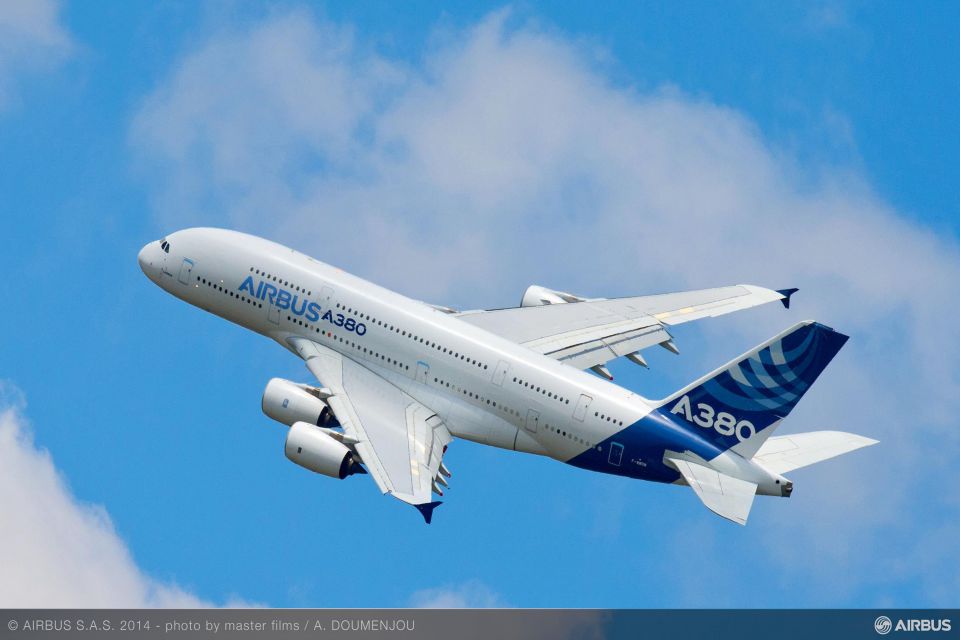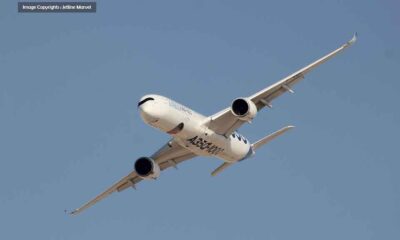Aviation
Airbus and Heathrow celebrate 10th anniversary of first A380 flight to London

London, 19 March 2018 – Airbus and Heathrow airport are celebrating the 10th anniversary of A380 operations at the airport. They began on March 18th 2008 with the arrival of the first A380, a Singapore Airlines flight SQ308 from Singapore Changi airport making Heathrow one of the first to welcome Airbus’ iconic double decker.
Heathrow is now the world’s busiest A380 airport by number of A380 operators with nine airlines* operating to 13 destinations on some 50 A380 daily flights. Heathrow serves 78 million passengers a year of which, 10% are travelling on A380.
Passenger traffic doubles every 15 years and the A380 is and remains the best solution for absorbing growth by using aircraft slots more efficiently; especially where airport capacity is limited. Like no other aircraft, the A380 unlocks growth in a comfortable and eco-friendly way. The A380 is also a good neighbour and won a UK noise abatement society award in recognition of its low noise operations, generating 50 per cent less noise energy on departure than its nearest competitor, as well as up to four times less when landing.
Simon Eastburn, Director of Airline Business Development at Heathrow said: “It’s been fantastic to see nine of our airlines welcome the Airbus A380 over the past decade. Ten years from first flight, this pioneering aircraft has helped us reduce noise and improve efficiency whilst supporting continued passenger demand for long haul routes. This is one of the most popular aircraft for many passengers so we look forward to celebrating this milestone with them.”
To date, more than 200 million passengers have enjoyed the A380 experience. According to a survey carried out by Epinion, 98% of A380 passengers would recommend flying on the A380 to their friends and family, and 60% are willing to make an extra effort to fly with the aircraft.**
As the smoothest, quietest flight, it offers unparalleled comfort in all classes. A modern feat of engineering and design, the A380 is the universally recognised benchmark. It provides airlines with a canvas to create the most outstanding business and first classes in the air, with amenities like showers, beds, bars and lounges.
Flying with the world’s leading airlines on over 120 routes and 60 destinations, the A380 is the passenger’s favourite. Airbus’ iconic superjumbo jet offers more personal space and the widest seats in the sky in all classes, including economy class.
Building on passengers’ excitement around the flagship A380, Airbus launched in 2016 the first booking assistant of its kind: iflyA380.com. In January 2018, following the website’s success, Airbus unveiled the iflyA380 app, which enhances the website with more choices, features and content and new possibilities to interact with the A380.
David Dufrenois, Head of A380 Market Development at Airbus, said: “. The A380 is essential to the operations of Heathrow, which is today the first hub in the world for long haul traffic. As 70% of long haul-traffic connects through hubs, the unique A380 offer strengthens Heathrow’s passenger appeal over other airports.”
To celebrate the tenth anniversary, Airbus and Heathrow will surprise passengers landing at Heathrow on an A380 flight from 18 to 28 March with A380 goodies. Ten lucky passengers will also receive VIP packs to continue their journey to London in style, including complimentary Porter service at the airport, Heathrow Express Business First tickets to Central London or WeKnowLondon Chauffeur Drive to winners’ chosen address, and a £250 WeKnowLondon voucher.
[embedyt] https://www.youtube.com/embed?listType=playlist&list=PLmSyYYke1dXPoknUYDb1ibZX1UfpU8x34&v=X8IHB5ql9v4&layout=gallery[/embedyt]

Aerospace
India is set to build a central command for the Air Traffic Control system, called ISHAN

India’s air traffic growth has led to increased responsibilities for air traffic control. The Airports Authority of India (AAI) is considering centralizing air traffic control for aircraft, dividing the country into four regions. The goal is to consolidate India’s segmented airspace into a single entity to improve air traffic management (ATM) efficiency, safety, and smoothness.
Recently, the AAI invited expressions of interest to develop a detailed project report for the Indian Single Sky Harmonized Air Traffic Management (ISHAN) initiative in Nagpur. Under this plan, air traffic controllers in Nagpur would handle domestic flights flying above 25,000 feet, eliminating the need for coordination among controllers in different regions.
For domestic regional flights operating above 25,000 feet, control would shift to the central command in Nagpur. This consolidation aims to enhance airline operations, increase flight handling capacity, and reduce congestion and flight times for passengers.
Currently, the AAI provides ATM services over Indian airspace and adjoining oceanic areas, covering over 2.8 million square nautical miles. This airspace is divided into four flight information regions (FIRs) in Delhi, Mumbai, Kolkata, and Chennai, along with a sub-FIR in Guwahati.
FIRs are responsible for providing air traffic services, including weather information, visibility, and search and rescue assistance. The proposed unification under the ISHAN initiative aligns with the projected growth of the aviation industry, which anticipates a doubling of domestic passenger traffic by 2030.
Aviation
Airbus is set to increase the production rate for the A350 as demand surges

Airbus SE is set to boost production of its advanced A350 widebody jet as it capitalizes on rising demand for long-distance travel and wide-body aircraft, amidst the ongoing crisis affecting its competitor Boeing due to issues with the B737 Max.
The surge in orders for Airbus’s A350 aircraft has instilled confidence in the company, prompting them to ramp up production rates. This move is particularly advantageous as Boeing continues to grapple with production quality issues surrounding its 787 and 777x aircraft.
In 2024 alone, Airbus has received 137 orders for the A350, signaling a need to expand manufacturing capabilities to meet customer demands. With 1,277 orders received and 592 aircraft delivered as of April 2024, Airbus is poised to fulfill pending deliveries efficiently.
The European aircraft manufacturer announced plans to increase production of A350 jets to 12 per month by 2028, surpassing earlier projections aiming for 10 per month by 2026. This decision was disclosed alongside the company’s first-quarter figures.
The Asian market is proving lucrative for the A350, with significant orders from airlines like Indigo and Air India, totaling nearly 70 aircraft commitments for the future. Meanwhile, Airbus is progressing with its A220 and A320 programs, aiming for a monthly production rate of 14 and 75 aircraft, respectively, by 2026. Additionally, the long-range A321XLR is anticipated to commence service in the third quarter of the current year.
In contrast, Boeing has been compelled to scale back production due to regulatory pressures aimed at enhancing factory processes. While Airbus anticipates a positive market outlook, Boeing continues to face challenges with FAA certification and quality approvals, resulting in ongoing delays for its 737 Max and 777x models.
Financially, Boeing reported a significant cash burn of $3.9 billion in the first quarter, leaving it with $7.5 billion in cash and short-term securities by the quarter’s end, down from $16 billion at the beginning of the year. Consequently, Boeing’s stock has plummeted by 38% in the year so far, contrasting with Airbus’s 14% gain, marking Boeing’s lowest performance in over a year.
For a full listing including details on customers and regions, as well as historical data for the previous year, go to the download section below.
- March 2024 deliveries: 63 deliveries to 32 customers
- March 2024 gross orders: 137
- 2024 deliveries to date: 142 deliveries to 45 customers
| Single-Aisle | A300/A310 | A330 | A340 | A350 | A380 | TOTAL | |
|---|---|---|---|---|---|---|---|
| Total Orders | 19470 | 816 | 1774 | 377 | 1277 | 251 | 23965 |
| Total Deliveries | 11705 | 816 | 1598 | 377 | 592 | 251 | 15339 |
| Aircraft in Operation | 11007 | 271 | 1482 | 202 | 591 | 234 | 13787 |
Aviation
All passengers killed in plane crash, after pilot let his children to control the plane

When boarding a plane, passengers entrust their safety to the skilled hands of the pilot. However, tragedy struck when one of the flight ended in disaster as all passengers lost their lives in a horrific plane crash.
In 1994, during a flight from Moscow to Hong Kong, tragedy struck as an Aeroflot relief pilot made a fateful decision. In a move that would have devastating consequences, the pilot invited his own children into the cockpit to play with the controls. Little did anyone know, this seemingly innocent gesture would lead to the loss of all 75 lives aboard the aircraft.
It was a seemingly innocent act that led to catastrophic results. The relief pilot, Mr. Kudrinsky, invited his two children, Yana, 12, and Eldar, 15, into the cockpit during the late hours of the night. Little did anyone know, this simple gesture would set off a chain of events that would end in tragedy.
Once in the cockpit, the children were allowed to sit in the captain’s chair and play with the controls, unaware that they should have been disabled as the plane was in autopilot mode.
Eldar, perhaps in a moment of curiosity or innocence, held the control column down for a mere 30 seconds. Yet, in those brief moments, the autopilot disengaged, thrusting the aircraft into manual control.
By the time the pilots regained their seats and attempted to regain control, it was too late. Despite their efforts to pull the plane out of a dive, they overcorrected, causing the flight to climb almost vertically, ultimately stalling it.
Final moment Flight 593 crash
In the final moments, as the pilots struggled to stabilize the aircraft, Flight 593 crashed into the Kuznetsk Alatau Mountain range in southern Russia, completely obliterating the plane and claiming the lives of everyone on board.
Investigations revealed a chilling truth: there was no evidence of technical failure. Instead, the crash was attributed to the unthinkable decision to allow inexperienced hands to manipulate the controls of a commercial aircraft.
The black box recording captured the harrowing sequence of events, providing a grim reminder of the human cost of a lapse in judgment. In just over two minutes, the lives of all on board were tragically short, leaving behind a legacy of sorrow and unanswered questions.





























